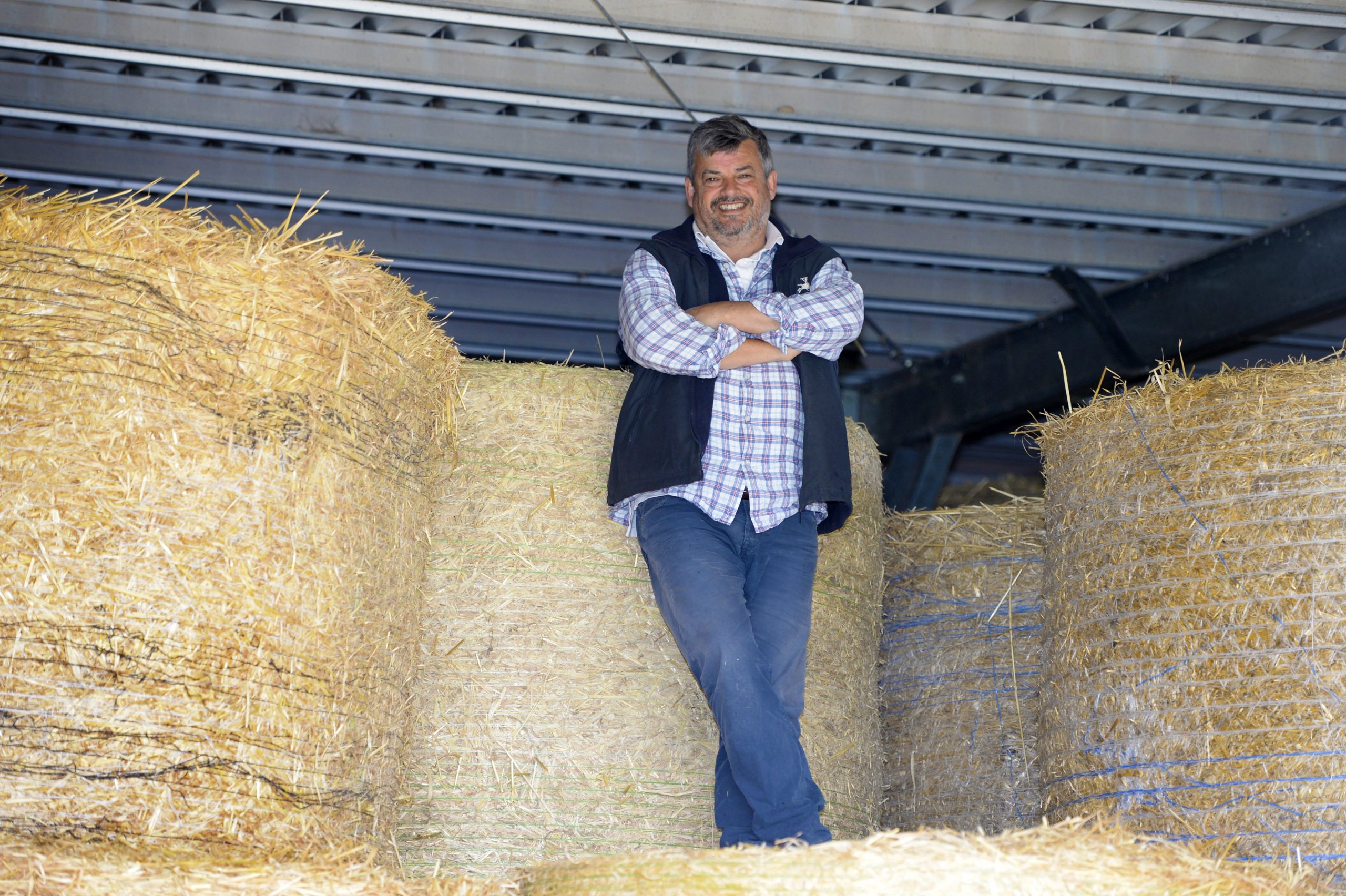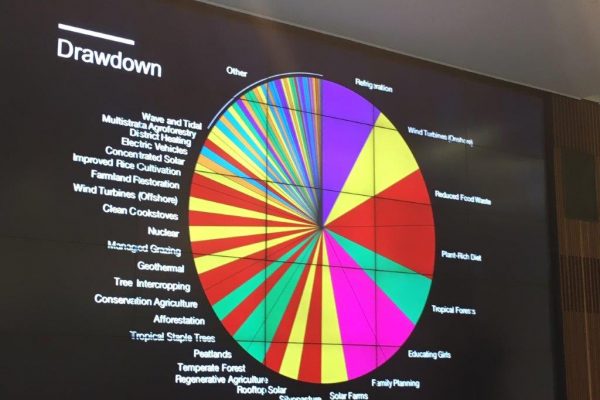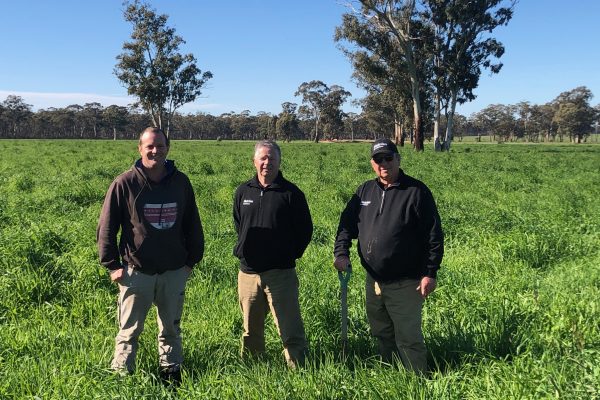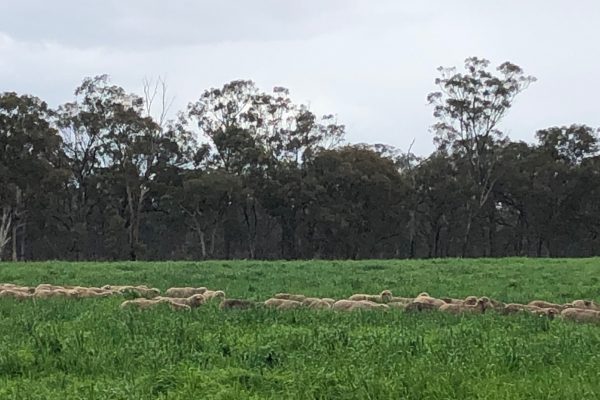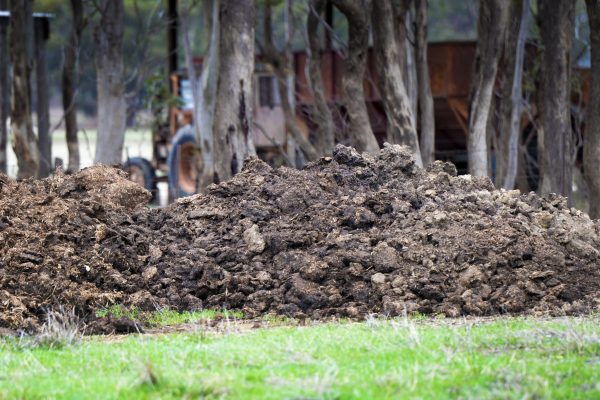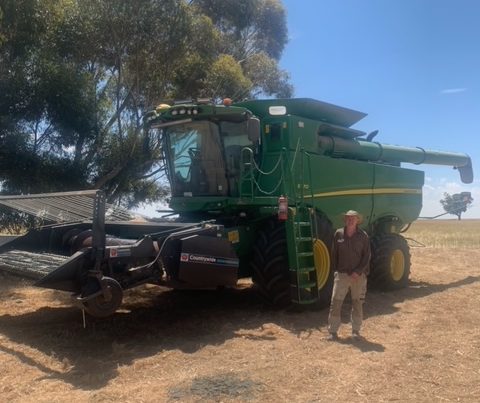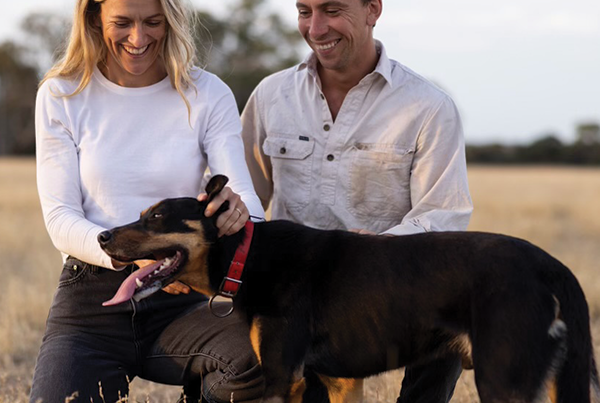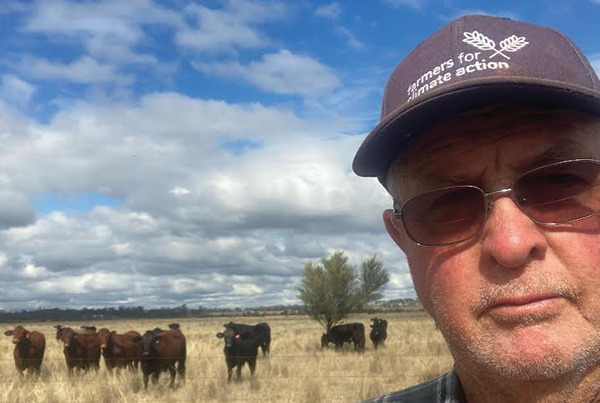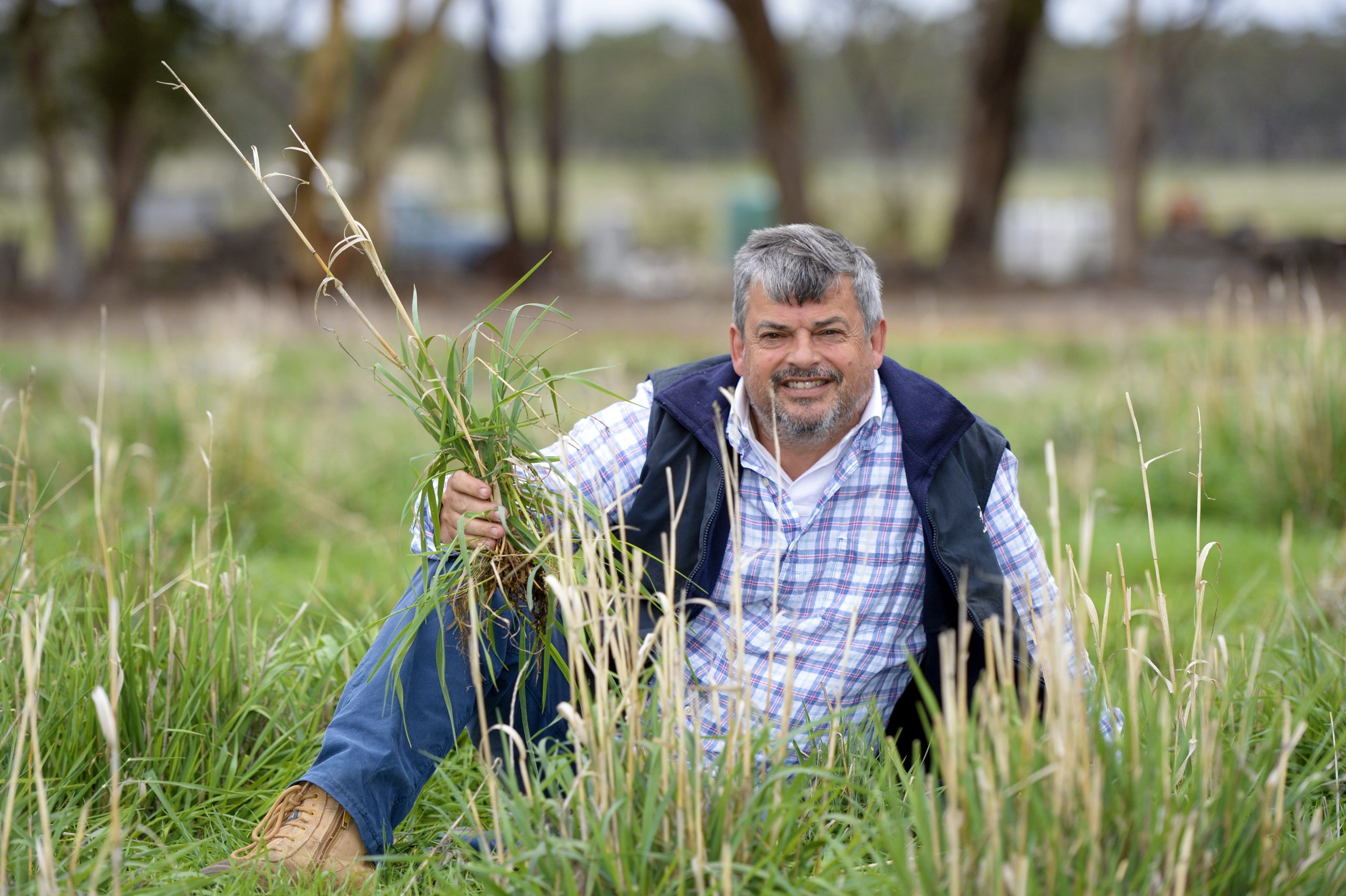
At a glance
Who: Sam McCardel, Climate Smart Masterclass participant in 2018
What: Small Sheep, Cattle and Cropping enterprise of 426 Acres with diverse other income streams. Solar powered. Pig manure soil improvement program. Seeking to establish a bush retreat facility to promote personal and environmental wellness
Where: North East Victoria, specifically 2km SE of Whroo, between Nagambie & Rushworth on Reedy Lake Road.
Can you tell us about your property?
In 1964, my father, an accountant by career, thought two-hours north of Melbourne was about the right spot to buy a farm. I became the second-generation absentee farmer of that property. My father cleared the land, and I have since built up everything on it in the last 30 years: six houses, numerous sheds, a larger wether wool sheep herd, and additional farm enterprises including fat lambs, rentals, hay sales, machinery sales, firewood sales, manure sales, and hopefully, in time, the Bush Retreat Wellness Centre.
Traditionally, the farm was primarily focused on fine micron wool in a 16-20” rainfall region, on what was fairly poor country (ironstone with a clay base and little top soil). Stocking rates were 1 DSE per acre, and we relied on conventional fertilizer; Mono-Ammonium Phosphate (MAP). I supplemented this with crossbred fat lambs (Merino X Border Leicester), oaten and wheaten hay crops and an abundance of enthusiasm for environmentally-friendly alternatives; solar power, relocated houses, and a soil improvement program.
Gary, my loyal care-taker and farm hand of 15 years’ assists me to run the farm, a labor of love, along with casual workers and sub-contractors as needed.
What first got you thinking about climate change?
Our deteriorating farming conditions and noticing the change in local farming practices; nearby vineyards now all harvest a month earlier in February, when they always used to harvest in March. The rising temperature ripens the grapes more quickly. I’ve always thought about how to make the farm more profitable in what appears to be declining situation from the old norm. We have less rainfall, hotter summers, more volatile weather, and the endless challenge of rising costs. Adrian Weston, our adjacent Campaspe Shire Mayor, and a member of the local Catchment Management Authority, advised me years ago that they have observed the dry climate was moving south by an estimated 9km per year from NSW, which explained the slow change being seen. So in 2-3 decades, the central NSW is likely to be typical of Northern Victoria.
How has climate change impacted on your farm business?
Like many farmers, I had watched with increasing dismay as dry conditions wore down our pasture and we faced the rising cost of feeding livestock in lean years. Increasingly hotter summers, and less (but more volatile) annual rainfall has reduced pasture growth, lowered the stocking rate, required a longer period of feeding out between November and May, which has knocked-on to greater labor costs and having to buy in fodder.
Our local land is not high-quality country, with minimal water holding capacity, little topsoil and salinity issues. The soil was like concrete in summer and soup in winter. A worsening climate situation has made worse our unwitting damage to our soils’ natural biology from the detrimental effects of sulphuric acid coatings on conventional fertilizer (MAP, DAP, Super), and increasing salinity (exacerbated by deep-rooted vegetation clearing where the water table is low), causing our soil to become increasingly inert (lack of soil biota) .
What are some of the climate-smart strategies you’ve been employing and how successful have they been?
We have always embraced solar power out of our isolated necessity, including solar pumps, but coming out of the Farmers for Climate Action (FCA) Climate Smart Masterclass I attended in February, 2018 in Seymour, which I was impressed with; professionally run, all presentations from empirically based science, and good conveners, I was so enthused I initially reviewed the possibility of a methane-powered micro grid digester from the piggery two km down the road. However, this turned out to not be viable on a small scale, and unfortunately the local powerline could not support it for surplus power feedback into the grid being SWER.
After the masterclass, I was fortunate to hear two lectures given by Paul Hawken and buy a copy of his book, Drawdown, which gave me much needed hope about what we are doing as one humanity to save the planet.
However, one of the many presentations which inspired me at the masterclass was carbon farming as a way to capture & reduce carbon emissions. I found this fascinating, pragmatic and immediately useful. Here was something I could do for the environment, which would add value to the soil, and productivity to the farm, by improving pasture growth, stocking rates and bottom-line profitability.
After the masterclass I researched the Federal Government’s Program for carbon farming as with such clear and direct benefits tied directly to productivity; it was a no brainer. According to promoters of the scheme, such as Corporate Carbon, “an estimated 1% increase in soil carbon per hectare adds 140,000 litres of water holding capacity, which allows for a longer growing season, greater draught tolerance, and improves soil fertility.”
Clearly, adding compost to the soil is an effective strategy to improve structure, water retention and boost grazing fodder, allowing more plant growth through greater photosynthesis and root depth. Improving feed quality improves profitability, by increasing stock growth, while it also builds organic carbon matter in the soil, sequestering carbon dioxide. “Compost is ideal for rebuilding soil fertility and nutrient levels: it contains macro and micronutrients; a diverse microbial population; stable organic compounds (such as humic substances); and labile organic matter used as food and energy for plants.” (Corporate Carbon)
The Federal Government’s scheme offers carbon credits to encourage engagement in carbon farming to capture emissions, and link them through the Emission Reduction Fund (ERF) to the long timeframe to ultimately receive tradable carbon credits (about ten years). But this did not weigh up for my immediate priority to increase productivity and reduce costs. Soil auditing was about $30k plus a lot of administration such that I decided to just get on with it, without signing up to the ERF scheme.
With the piggery down the road having a stockpile of excess manure (over 10,000 tons) it could not offload, the introduction afforded by FCA Masterclass, and by some due diligence and capital investment (A Truck and Super Dog, A Manure Spreader, and a Front End Loader), we just got down to work with our own home-grown soil improvement program.
Gary and I created our own formula to economically unlock the full potential of the farm, and with faith in science, we set out to convert our low-grade soil hobby farm into a more profitable wool, fat lamb, and cropping enterprise by spreading pig manure to replace using conventional fertilizer with a natural carbon capture process, improving the soil biology, the pasture and reducing carbon emissions as a bonus.
Basically, we seek to improve the old ‘NPK’ (Nitrogen-Phosphorus-Potassium) formula using with a local, cheap, underestimated fertilizer which is high in Nitrogen and Phosphorous anyway. With rising cost of inputs and drier conditions, this was a timely move to lift productivity, improving soil fertility and retaining soil moisture by closing the nutrient loop.
I signed a contract with the piggery which solved two problems in one hit. The piggery was relieved of the risk of environmental contamination and costly waste management and removal, and I had a veritable mountain of cheap fertilizer, but not without a catch. I first had to spend a considerable amount to buy a slurry tanker, a truck-and-dog, hire an excavator and front-end loader, and several truck-and-dog drivers, before I got stuck into shifting the 10,000 tons of semi-matured pig manure down the road to my farm. In all, it cost me around $30,000 to transport and $20,000 to spread on the property. But looking back it has all been more than worthwhile.
In 2018 I applied about 30t/ha, turning it into a small but impressive oat crop, and top-dressed all the pasture at 5t/ha; giving me the only crop in the district to be baled in a low-rainfall year. We grew two successful oat crops last year, without any conventional fertiliser. The manure clearly goes much further than just replacement fertilizer, as it is organic, environmentally much friendlier, improving soil quality year-on-year, bringing back worms, humus into the soil, birds and wildlife. The water-holding capacity of the soil has dramatically improved, and the life in the soil just writhes out of the musky rich dark loam. The soil has come back to life. The diversity of the grasses has also increased and the rootstock depth has improved dramatically. That’s why we can now stand the drought when neighbouring properties can’t so well.
That said, it is important to ensure excess application doesn’t cause nitrification imbalance in the local ecosystem, something I have sought advice on and ensure I manage within regulations.
We are now baling six rolls of round bales per acre. We have more than doubled our stocking rate. The stock are loving it, shoulder deep in Phalaris (see photo), and the birds are back in numbers. One agronomist even brings his client to view my pasture (see photo). We sell raw organic manure to a growing list of clients, including everything from dairies and orchards to cropping farmers and hobby farmers who are all seeking to improve the biology of their farms with a more land-friendly and competitively priced product. Appropriately managed, pig manure solves multiple issues: improving soil biology, and pasture, through increasing carbon capture, with excellent NPK levels, and a reduced cost. What more do you need?
Thank you to Corey Watts (FCA’s Victorian Co-coordinator) and then FCA CEO, Verity Morgan Schmidt, for including me in the 2018 masterclass at Common Ground, Seymour. It was an extremely well organised, eye-opening and empowering three days.
Photo credits: Megan Fisher, Country News

